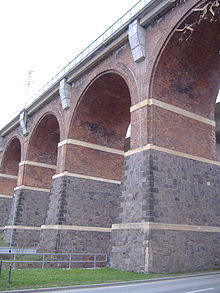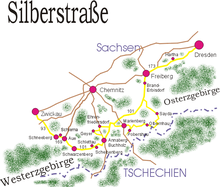Zwickauer Land
County council election 2004
Voter turnout: 46.1 % (1999: 54.8 %)
%
40
30
20
10
0
37,4 %
23,3 %
16,9 %
11,1 %
8,7 %
2,6 %
n. k. %
CDU
PDS
FWV
FDP
SPD
Green
DSU
Profits and losses
compared to 1999
%p
8
6
4
2
0
-2
-4
-6
-8
-10
−9,5 %p
+7,0 %p
+7,6 %p
+1,6 %p
−6,4 %p
+0,2 %p
−0,5 %p
CDU
PDS
FWV
FDP
SPD
Green
DSU
Template:Election Chart/Maintenance/TITLE too long
The district of Zwickauer Land was a district in the southwest of the Free State of Saxony. Neighbouring districts were the Altenburger Land district in Thuringia to the north, the Chemnitzer Land district to the north-east, the Stollberg district to the east, the Aue-Schwarzenberg district to the south, the Vogtland district to the south-west and the Greiz district in Thuringia to the west. The independent city of Zwickau was almost entirely surrounded by the district of Zwickauer Land. The district of Zwickauer Land was merged into the district of Zwickau with effect from 1 August 2008.
Geography
The district of Zwickauer Land lay in the southwest of the Free State of Saxony. To the southwest lay the Vogtland, to the south and southwest the Erzgebirge. The Zwickauer Mulde and the Pleiße rivers flowed through the district.
A dense network of paths opened up the hilly region, where meadows and fields alternate with wooded ravines and small forests.
See also: List of Landscapes in Saxony, List of Water Bodies in Saxony and Natural Areas in Saxony.
Economy
The region is traditionally characterised by mining, vehicle manufacturing, textile industry, toolmaking and mechanical engineering. Thus, the district had a diversified labour force potential due to more than 100 years of industrial development. In addition to large companies such as VW Sachsen and GKN (in Zwickau-Mosel), Buderus, Saxas, it was mainly small and medium-sized businesses that shaped the economic strength of the region. Tourism was developed in the district, and the Silver Road ran through it. The district was a member of the Chemnitz-Zwickau economic region.
Traffic
The district was intersected by the motorways 4 and 72 as well as the federal roads 93, 173 and 175. There was a rail connection to Dresden and Nuremberg from Zwickau main station. There were also direct connections to Hof, Plauen, Chemnitz, Aue, Johanngeorgenstadt, Kraslice, Altenburg, Leipzig, Gera and Göttingen. Local transport was provided by the Regionalverkehrsbetriebe Westsachsen, a company in the Mittelsachsen transport association. The
nearest regional airport was Leipzig-Altenburg Airport, where Ryanair, among others, flew to London-Stansted.
History
The regional administration in Saxony was given a new structure in 1835. The district governors were replaced by the four district directorates of Dresden, Leipzig, Bautzen and Zwickau. The district governors in Zwickau, Chemnitz, Wolkenstein, Plauen and in the Schönburg regencies belonged to the Zwickau district directorate. In turn, the offices in Zwickau, Kirchberg, Werdau, Schwarzenberg and Eibenstock were subordinate to the district governor of Zwickau, and the offices in Hartenstein, Lichtenstein, Stein, Waldenburg and Glauchau were subordinate to the district governor of the Schönburg regencies.
With the establishment of new court and administrative offices - the Gerichtsämtern - an important step towards "modern administration" was taken in 1856. The old division of offices in its confusion could thus be overcome.
In 1873, the judiciary and administration were separated; the court offices were only responsible for the judiciary, while the newly formed Amtshauptmannschaften took over the administrative tasks. Four district governorships were established as direct organs of the Saxon state government in place of the old district directorates. The Zwickau district administration consisted of the district administrations of Annaberg, Auerbach/Vogtl., Chemnitz, Flöha, Marienberg, Oelsnitz/Erzgeb., Plauen, Schwarzenberg and Zwickau.
In 1878, the Saxon state took over the judicial and administrative sovereignty in the Schönburg rezessherrschaften and formed the Amtshauptmannschaft Glauchau. A branch office of Werdau was created in 1919, which became an independent Amtshauptmannschaft in 1920, but reverted to Zwickau in 1933.
The municipal constitution of 1946 and the Saxon constitution of 1947 re-established democratic conditions in the state of Saxony as they had existed before the beginning of the Hitler dictatorship.
The administrative reform of 1952 liquidated the state of Saxony. At the same time, the district area was divided into the districts of Werdau and Zwickau-Land. Part of the district area also went to the new district of Reichenbach. In contrast, the Mülsengrund was removed from the district of Glauchau and added to the district of Zwickau-Land.
The fall of the Berlin Wall on 9 November 1989 was part of the Wende. With the elections to the Saxon state parliament on 14 October 1990, Saxony was finally re-established after 38 years.
After reunification, the districts of Zwickau and Werdau were able to establish partnership relations with the Hessian district of Darmstadt-Dieburg, the Bavarian district of Kulmbach and later with the district ofMiesbach.
Local elections were held on 6 May 1990. At the constituent meeting of the district council, Christian Otto was elected district administrator. In the district of Werdau, the citizens elected Georg Hamburger as district administrator.
With the district reform, the district of Zwickauer Land was created on 1 August 1994 from the former districts of Zwickau and Werdau and from the two municipalities of Dennheritz and Schlunzig, which had previously belonged to the district of Glauchau. At that time it enclosed the independent city of Zwickau like a collar. With the completion of the municipal area reform on 1 January 1999, the district changed its geographical face once again. The villages of Cainsdorf, Mosel, Oberrothenbach and Schlunzig were incorporated into the city of Zwickau. Legal actions were unsuccessful. In the preceding years, the villages of Crossen, Schneppendorf and Hartmannsdorf had joined Zwickau on a voluntary basis. The so-called collar circle was broken. The city of Zwickau now bordered directly on the Chemnitzer Land district in its northern area.
The administrative district of Zwickauer Land was merged into the new administrative district of Zwickau with effect from 1 August 2008.
Buildings
The district possessed a rich archaeological and architectural heritage from centuries of settlement history.
Particularly characteristic were the elongated wooded villages that had spread out in the side valleys of the rivers. The castle-like three- and four-sided farmsteads gave them an unmistakable character. The density of early German ramparts was unique in the Free State. Structural witnesses from almost all stylistic epochs were to be found. There were also Umgebindehäuser (half-timbered houses) in the district, typical of the region. The villages and small towns still had largely unspoilt marketplaces and centres and occasionally showed traces of the High Middle Ages.
Unique sacral interior decorations in many churches, mostly located in the town centres, testified to high culture. Altars and altar pieces by Peter Breuer, for example, in Culitzsch, Mülsen St. Jacob and Thurm, Hartmannsdorf, Härtensdorf, Stangengrün, Weißbach, the Silbermann organ in Fraureuth or the Schlunzig Baroque organ by J. J. Donati the Elder attracted visitors from far and wide. The Cistercian nunnery in Crimmitschau/Frankenhausen was also well-known. Villas in various architectural styles, half-timbered houses, castles and palaces held interesting stories from the past.
In the Zwickau region, almost all the castles, palaces and manors were preserved. Important contemporary witnesses were Blankenhain Castle, which housed a museum, Leubnitz Castle, Schweinsburg Castle, Wiesenburg Castle, Wildenfels Castle, Schönfels Castle and Stein Castle. Steinpleis Castle was built in 1858 in the English Tudor Gothic style. Lauterbach Castle in Neukirchen/Pleiße was built in 1884 in neo-Renaissance style as the manor house of the Lauterbach estate. Between 1907 and 1909, Henry van de Velde carried out his largest and most important redesign of the interior, which elevated the castle from the class of historicist manor houses to the rank of a cultural monument of supraregional significance.
The most visited castle was Blankenhain Castle, which serves as an agricultural and open-air museum - a unique complex in Saxony. The Blankenhain manor burnt down in 1661. It was rebuilt by 1700 and modernised in 1784. Most recently, the beautiful complex still showed its characteristic mansard roofs and baroque tower bonnets on the two angular Renaissance towers. The manor house was saved from demolition in 1975 and has been an agricultural museum since 1981 with many valuable tools from the farming economy and past.
The "Silver Road", now known as the Holiday Road, began in Zwickau, and along its course to Dresden there was evidence of mining from its heyday to its decline.
The art of building and technical progress were also reflected in the bridges built at different times. The railway bridges and viaducts of the Leipzig-Hof and Werdau-Zwickau lines were built between 1843 and 1851 and were predominantly brick structures with arch construction made of local bricks from the Leubnitz and Werdau brickworks. The Leubnitz, Steinpleis and Römertal viaducts are known as the "little sisters" of the famous Göltzschtal bridge near Netzschkau. These bridges are admirable testimonies to technical development in the 19th century. The road and motorway bridges wrote their own chapter. The motorway bridge near Wilkau-Haßlau spanned the Mulde valley at a height of 45 metres over a length of 700 metres.
With the expansion of the A 72, the structure received a new superstructure that connects the valley shoulders on the slender, 60-year-old piers, visible from afar. With the expansion of the long-distance connection from Frankfurt am Main to Dresden to the six-lane A 4, the new bridge over the Pleißental near Crimmitschau-Frankenhausen was completed in the 1990s.

Leubnitz Viaduct, brick building from 1845

Map of the Silver Route
.jpg)
City Hall in Werdau
.jpg)
Blankenhain Castle
Cities and municipalities
(Population figures as of 31 December 2006)
| Cities |
|
Administrative communities
| Communities
|
Vehicle registration number
On 1 August 1994, the district was assigned the distinguishing sign WDA, which had been valid for the district of Werdau since 1 January 1991. This was replaced on 1 January 1995 by the new distinguishing sign Z, which is still used in the district of Zwickau today.
Questions and Answers
Q: What is Zwickauer Land?
A: Zwickauer Land was a rural district located in the south-west of the Free State of Saxony, Germany.
Q: Which city is in the middle of the district?
A: The independent city of Zwickau is in the middle of the district.
Q: Was Zwickau always under the control of the district government?
A: No, Zwickau lost its right to administer itself and became a city under the control of the district government in July 2008.
Q: When was the rural district created?
A: The rural district was created on August 1, 1994.
Q: Which town is the capital of the district?
A: The capital of the district is Werdau.
Q: Was there a reorganisation in the district? If so, when?
A: Yes, the district was reorganised on January 1, 1999.
Q: Which towns were made a part of Zwickau during the reorganisation, and how did the people living in those towns feel about it?
A: Cainsdorf, Mosel, Oberrothenbach and Schlunzig were made a part of Zwickau during the reorganisation, and the people living in those towns wanted to stay independent.
Search within the encyclopedia